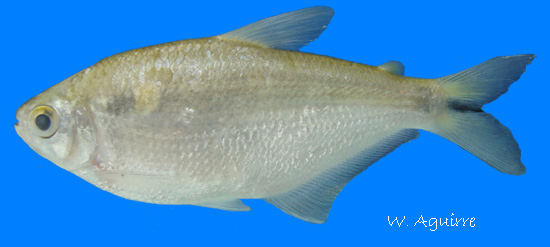| SOURCE FOR OCCURRENCE IN ECUADOR: This species is very common along the western slope of southern Ecuador. There are many references for its occurrence in the area (e.g., Eigenmann, 1922; Eigenmann, 1929; Böhlke, 1958; Ovchynnyk, 1971; Gery, 1977; Glodek, 1978; Laaz et al, 2009; Laaz & Torres, 2010; Jimenez et al., 2015). |
| ORIGINAL DESCRIPTION: Günther, A. 1860. Second list of cold-blooded vertebrata collected by Mr. Fraser in the Andes of western Ecuador. Proceedings of the General Meetings for Scientific Business of the Zoological Society of London 1859(pt 3):402-420. |
| TYPE SPECIMENS: |
| TAXONOMIC STATUS: Valid (Eschmeyer and Fricke, 2011) although a comprehensive survey of the tetras in western Ecuador is necessary. This species was known until recently as Bryconamericus brevirostris. Thomaz et al. (2015) moved it to the genus Eretmobrycon. |
| RANGE ECUADOR: Esmeraldas and Guayas basins of western Ecuador (Glodek, 1978). |
| RANGE OUTSIDE OF ECUADOR: Northern Peru (Glodek, 1978). |
| COLLECTIONS IN ECUADOR: |
| MAXIMUM SIZE: 12 cm (Laaz et al, 2009). |
| DISTINGUISHING FEATURES: Eretmobrycon brevirostris differs from other characids by the combination of the following characters: body compressed, anal fin rays counts 34-39, lateral line scale counts 43-50, two obscure humeral spots formed by the absence of many chromatophores over the 7th-8th scales of the lateral line, middle caudal rays conspicuously black (Eigenmann, 1929). |
| ECOLOGY: This species is known in Ecuador as the “cazuela” or "cachuela". It is an omnivorous characid (Laaz et al, 2009). |
| ECONOMIC IMPORTANCE: This species is not exploited as a food fish because of its small size. |
| CONSERVATION STATUS: NA, although the species is not directly exploited as a food fish and appears to be common in the area. |
| LINK TO FISHBASE PAGE: Click here for link |
| SPECIES PROFILE CREATED BY: Enrique Laaz |
| SPECIES PROFILE CONTRIBUTORS: Windsor Aguirre |
